Pictured Above: DEPTH OF FIELD. Maintaining crop diversity, including strip-tilled sorghum, is essential on the 1,200-acre Boyle Farm operation in Coolidge, Ariz., to feed 2,800 head of cattle on the adjoining McClintock Dairy.
Satisfying the appetites of a few thousand head of cattle is the linchpin of Boyle Farms and McClintock Dairy, both multimillion dollar operations near Coolidge, Ariz.
Starting with a 160-acre plot of land purchased in 1998, Robert Boyle gradually pieced together a checkerboard of 1,200 farmable acres to supplement the family’s established dairy farm. Boyle manages the family’s cropping operations and is co-partner in the dairy business.
While the two operations had always been intertwined, it wasn’t until the family recently consolidated the dairy business in Arizona, that increased crop production became more critical.
“We were raising all our heifers in California, and then they would come back to our operation when they were 2 years old,” Boyle says. “It was cheap to feed the animals out there, but when the drought hit, it got more expensive. We decided to bring them all home, but that broadened the farming operation because now I have 2,000 more mouths to feed than I used to.”
Boyle’s diverse crop rotation includes silage corn, sorghum, alfalfa and wheat — all of which are flood irrigated and grown to feed the milk cows and heifers. The need to increase crop production and field operation efficiencies prompted a profitable transition from conventional tillage to strip-till 3 years ago.
“Between the tillage savings, the water savings and the hay savings, I’ve already depreciated out all my establishment costs and am looking at a $500 to $550-per-acre savings with strip-till.”
A ‘Closed-Loop’ System
Revenue from the farming operation is only about one-tenth of that generated by dairy business, but Boyle notes that one is mutually dependent on the other to succeed.
“We very much have a closed-loop system in that we want to cycle everything we can from the cropping operation through the dairy and vise versa,” he says. “The farm is a small part of the whole picture. But in terms of feed costs, that could be a dollar a hundredweight variance in a year, which is significant.”
Strip-till is one aspect of the system that has been a valuable cost-controlling tool, compared to the deep tillage methods Boyle previously deployed. After harvest, he’d typically make seven to eight tillage passes through the field, taking 2-3 months to prepare harvested fields for the next crop.
“I used to harvest our wheat forage crop in October, then have to work the ground the next 3 months to plant in February,” he says. “Now, I keep it in until February and get at least 2 more cuttings. Then I’ll strip-till corn into my winter wheat crop in March.”
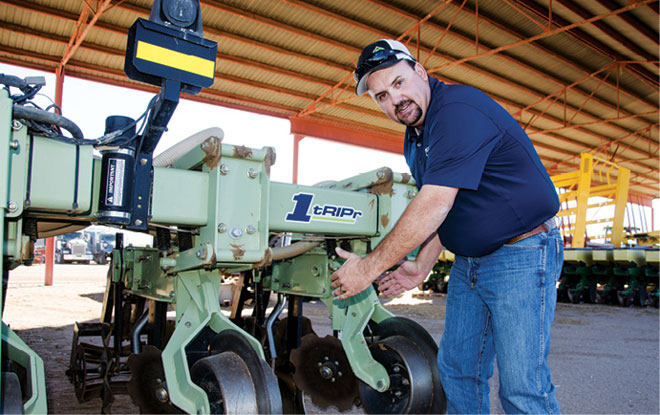
EQUIPMENT FIT. Arizona strip-tiller Robert Boyle runs an 8-row Orthman 1tRIPr but changed out the original fertilizer tubes on the row units and replaced them with Grow Zone fertilizer tubes. In a side-by-side trial on a strip-tilled corn plot, he found that fertilizer application through the Grow Zone tubes contributed to a 4-inch height advantage over the stock tubes.
On one half of the farm, Boyle’s typical crop rotation starts with winter wheat, followed by silage corn and then sorghum. Everything is cut for forage and he strip-tills ahead of each crop, making a pass with his 8-row Orthman 1tRIPr, in February, July and November. The other half of the farm is mainly alfalfa, which Boyle keeps in a 3-year rotation with strip-tilled corn.
“I look at the cropping operation as if I’m growing milk so before I even plant anything, I’m trying to figure out the end result,” he says. “If I can grow high-protein wheat silage, then I can be more economical with another feed cost. We like to feed lots of forages, so that’s why farming fits us well.
“But then we also like to prescription farm for our cows. We have a nutritionist here once a month and we go over our plans of how we want to feed. Then when we look at our ration costs and analyze nutrient requirements in the crop at a particular price and the revenue potential.”
Boyle admits deep tillage was “wearing out” his sandy and clay loam soils and he began to see inconsistencies in yields and declining soil health based on sampling. In some fields with an alfalfa-silage corn rotation, Boyle was seeing annual corn yields dip by as much as 5 tons per acre.
An ongoing cover crop experiment (see sidebar on pg. 88) is one way Boyle is looking to rebuild his soils, but he’s already seen marked improvement from strip-till.
“The ground is getting better and in one of our fields after our first strip-tilled corn crop, we saw the pH level drop from an 8.7 to 7.8,” Boyle says. “Our yields are starting to come back up and stabilize because we’re not having to come in and make 8 passes per field that would just turn our soil into powder.”
He’s also seen noticeable yield improvement. A typical silage corn harvest is 30 tons per acre, but Boyle says he had four fields yield 39 tons per acre in 2016.
“We still struggle with some of the poorer fields, but we’re working toward bringing the low-end yields up,” he says. “As we continue to repair those soils, I think we’ll starts to see those yields reflect that improvement.”
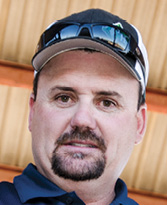
Robert Boyle
“Between the tillage savings, the water savings and the hay savings, I am looking at a $500 to $550 per-acre savings with strip-till…”
‘Multivitamin Plan’
Managing a diverse crop rotation requires a regimented fertility program with an overall focus on supplementing organic nutrients stored in the soil profile. Strip-till has helped accelerate some of the natural replenishment, but the system has also helped Boyle be more conscious of when, where and how much commercial fertilizer is applied.
“I think we’ve maximized our yields off of nitrogen (N), phosphorus (P) and potassium (K). The problem we have now is we’re running out of the little things,” he says. “Anytime I take a hay test, a corn silage test, we look at all the nutrients — copper, magnesium, cobalt and chlorides,” he says. “Anything that is deficient, we supplement. That’s where strip-till has been a real asset because I can include all of those trace elements.”
Using a pull-type Montag dry fertilizer cart behind the strip-till rig, Boyle applies a micronutrient starter package of 50-100 pounds per acre ahead of corn and sorghum. He calls it his “multivitamin.”
“I want everything in it and I want it in the strip,” Boyle says. “It’s like growing a houseplant in a pot. That’s the scenario I’m trying to create in my fields with strip-till. I’m not trying to save on my fertilizer costs. I’m trying to buy better nutrients and get a better combination. With that approach, I want to heal the soil.”
Ahead of corn and sorghum, Boyle also applies 200 pounds per acre of ammonium phosphate (16-20-0) and 100 pounds per acre of Tiger 90CR, a sulfur supplement, in the strip. Some irrigation wells pump water with salt content as high as 6,000 parts per million (ppm), so he says sulfur is an essential addition to their fertility program.
Boyle prefers to layer his fertilizer packages, applying 25% in the first 4 inches, another 25% at 4-6 inches and then the remainder at the bottom of the 12-inch-deep strip.
“We don’t do air drops or air release or anything. We’re blowing it in just as hard as the Montag will blow it into the trench,” Boyle says. “We did change out the original fertilizer tubes on the row unit and replaced them with Grow Zone fertilizer tubes. I met the creator, Adam Souder, at the National Strip-Tillage Conference and he happened to have one in his truck and it intrigued me.”
Growing Soil Potential with Cover Crop Experimentation
For many farmers, the growing season is finite each year, and choosing the right rotation can produce perpetual soil health and yield benefits. But for Coolidge, Ariz., farmer Robert Boyle, strip-tilling, planting and harvest are continuous tasks.
Crop rotations differ by field across his 1,200-acre operation, but he primarily grows corn, sorghum, wheat and alfalfa. During a recent visit to Boyle’s farm, No-Till Farmer editors had the chance to see this diversity up close with a field of shoulder high sorghum opposite a plot of 2-year alfalfa almost ready for its 11th cutting.
“One side of the farm is sand, which will set up like cement, and the other side is more of a clay loam,” Boyle says. “We typically have about a 50/50 rotation between alfalfa and corn and then the corn fields will either get winter wheat or barley, depending on what the nutritionist wants that year.”
Last year, Boyle made an experimental addition to the rotation, drilling in 12 pounds per acre of hairy vetch as a cover crop on 70 acres ahead of strip-tilled corn for silage. The field is in a rotation with alfalfa, and Boyle wanted to add a little more diversity to further develop soil biology and potentially retain additional moisture and nutrients.
“My goal is to change up the monoculture I’ve created in my cropping system,” he says. “The problem we face is that alfalfa is a 3-year crop, and corn is a 1-year crop. But we end up doing two to three crops of corn before we’re ready to rotate alfalfa, and corn-on-corn doesn’t work here because we’ll get 40 tons that first year of corn and then 25 that last year.”
Boyle’s plan is to let the hairy vetch get 10-12 inches tall then either do a burndown or shred the cover, then strip-till and plant corn. Based on his research, he could get upwards of 100 units of nitrogen carryover, but he’d be satisfied to get even 30.
He’s also hoping to make more efficient use of an abundant winter water supply, to help offset limited availability in summer.
“We get canal water and well water, but the canal water is rationed down in the heat of summer, so I have to cut back on my growing acres for certain crops,” Boyle says. “If I can grow a crop cheaply, while also building the soil up and cutting back on commercial fertilizer usage next year, I can see expanding cover crops from one-tenth of my corn acres to all of them.”
To test the product, Boyle conducted a side-by-side trial on a strip-tilled corn plot and found that fertilizer application through the Grow Zone tubes contributed to a 4-inch height advantage over the stock tubes.
For his alfalfa crop, Boyle often has to supplement 600 units per acre of N per year, and twice a year will sidedress 200 pounds per acre of ammonium phosphate and 100 pounds per acre of sulfur. He also balances out the N deficiency by pumping in lagoon water from the dairy.
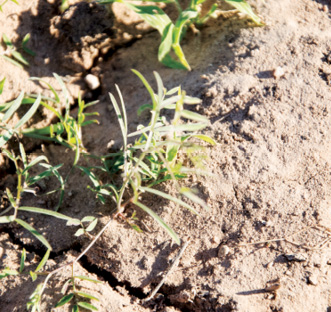
PROVIDING COVER. In 2016, strip-tiller Robert Boyle made an experimental addition to his crop rotation, drilling in 12 pounds per acre of hairy vetch as a cover crop on 70 acres ahead of strip-tilled corn for silage. The field is in a rotation with alfalfa, and he wanted to add a little more diversity to further develop soil biology and potentially retain additional moisture and nutrients.
Boyle is also experimenting with dry manure application on one of his strip-tilled fields. This past year, he applied 20 tons per acre in a harvested corn field and then incorporated it 2-3 inches deep with a Horsch Joker high speed disc.
“We think we can still come back and find the old strips easily that way, but our challenge has been incorporating it because we thought we had plenty of manure just from the lagoon water and then we’d sell the solid manure,” Boyle says. “But the water can be 12,000 ppm salt. The solid manure is actually where all the nutrients are, so we’re trying to use some evaporation ponds now that we’ve built to dry the manure water out and just use solids.”
The goal with the manure application is to have another economical source for nutrient supplements.
“That comes out in the manure,” Boyle says. “So whatever my crop was deficient in, it’s coming back. The cows have got it and they’re excreting it back out into the manure.”
Maximizing Moisture
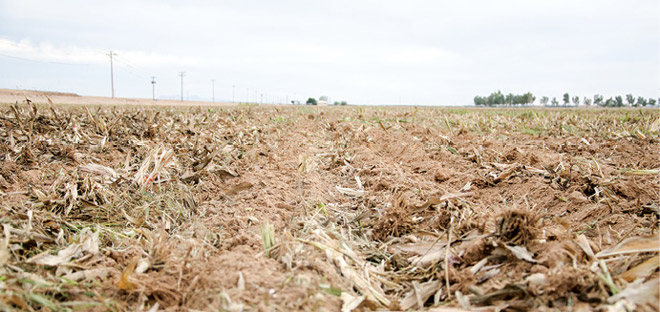
FERTILE GROUND. Each of the crops grown on Robert Boyle’s farm — including silage corn, sorghum, alfalfa and wheat — are cut for forage and he strip-tills ahead of each crop in February, July and November. “It’s like growing a houseplant in a pot. That’s the scenario I’m trying to create in my fields,” he says.
While the Boyles’ farming and dairy operations are efficient at cycling nutrients, moisture is a far more precious resource. Water for irrigation and the cows is drawn from either a 2,500-foot-deep well or a canal that draws from the Colorado River.
“All my shallow water — 600 feet and up — is 5,000-6,000 ppm salt. So to get good water for the cows, this farm had a deep well on it that was 1,500 feet deep and had good, sweet-tasting water,” Boyle says. “But it was hot. The water came out of the ground at 135 degrees, which is why we had to invest in a cooling system that processes 1,000 gallons per minute and lowers the temperature to 85 degrees.”
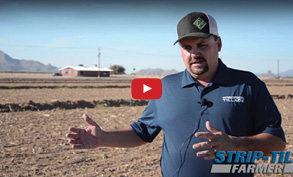
Successful Strip-Till in the Southwest
Hear more from Coolidge, Ariz., strip-tiller Robert Boyle on how he’s developed an efficient strip-till system that benefits diverse cropping and dairy operations. Visit www.StripTillFarmer.com to watch exclusive videos shot on location at Boyle’s farm.
Forthcoming regulations for how much water area farmers can draw annually from local sources was a motivating factor for Boyle to adopt strip-till. Better water infiltration and retention in the soils are two benefits he’s seen with the practice.
“Our corn is in 30-inch rows, so the idea is to have a hard strip in the middle and when the water flows over, it absorbs right into that berm much better than it ever did with full-width tillage,” Boyle says. “In the past, we’d apply about 4½-acre-feet of water on our corn, but we’ve saved about a half an acre-foot.”
That’s translated to about a $20-per-acre savings in water costs, and Boyle hopes the reduction in water usage will allow him to add acres in the coming years, without adding substantial costs.
“I’m looking to pick up another 400 acres, but I need to grow in size so I can farm the same amount of acres and bank feed once the water regulations kick in,” he says



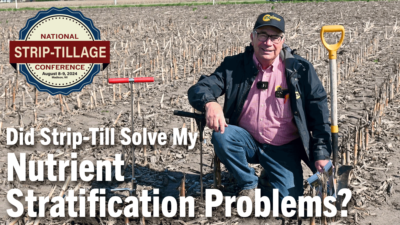



Post a comment
Report Abusive Comment